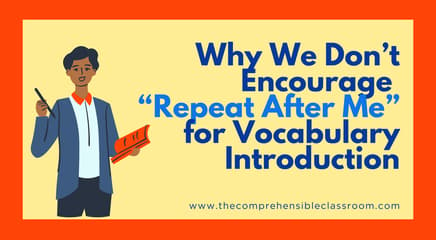ASK THE STORY: How to Use Matava-Style Scripts to Create a Class Story
This post is a detailed guide to how to ask a story using TPRS!
Some teachers are really great at creating class stories on the spot that provide zillions of repetitions of the target structures while still staying “in-bounds” (using only vocabulary that students already know). Others of us are not, and we require careful planning to take three simple structures and turn them into an engaging, comprehensible story.
But how can one plan a story to tell and still allow students to create it? The key lies in writing a story that includes details which can be changed; details that are not essential to the plot’s structure.
Anne Matava developed a way to write such story scripts in a format that allows teachers to remember what parts of the story are important and which are variable, and allows the scripts to be easily shared amongst teachers. Her method employs the use of two font styles:
Core Vocabulary*, or High Frequency Structures, are in bold. This helps them to stand out as we write scripts (so that we make sure that we include many repetitions of them) and to remind us as we use the script that we should not change those structures! They are essential.
Variable details are underlined. These are the details that should be “asked” of the students, and it is in these portions of the story that the class-created script will differ from the original, teacher-created script.
*You may also see Core Vocabulary referred to as 'target structures'
Telling versus asking
Anything that is not underlined should be told to the students: the teacher should strive to follow as closely as possible to those portions of the text, because it will ultimately allow for maximum repetitions of the target structures and minimal opportunities for out-of-bounds vocabulary to be introduced. As a teacher becomes more comfortable with storyasking--and more familiar with any particular script (after asking it to multiple classes for multiple years)--she or he will usually find that it is easier to stray from the script. However, at the beginning, it is advisable to follow it near-verbatim.
What does a Story Script look like?
Here is a sample of a Matava-style Story Script. This one is an excerpt from the story “¡Cierra la puerta!” (“Close the door!”) and can be found here. It is an expansion of a story described in Carol Gaab’s fantastic article, “The First Two Weeks”, available from Fluency Matters.
The Core Vocabulary for this story are “It’s (#) o’clock”, “opens the door”, and “never closes”. Notice that the times are in bold and underlined, because part of the Core Vocabulary itself (the exact time) is a variable.
In this story, students are able to choose (1) the characters, (2) the locations, (3) the ending.
This is Teakia. She is very intelligent, but she is also disobedient and irresponsible. She is a student at Clark Middle School.
It's seven o'clock. Teakia is going to school. Teakia says, "Bye, mom!" and opens the door of her house, but she doesn't close the door. Her mom says, "Close the door!" but Teakia doesn't close the door. Teakia never closes the door. Teakia's mom closes the door...
...It's nine o’clock. Teakia goes to Spanish class. Teakia opens the door, but she doesn't close the door. Mrs. Bex says, "Close the door!", but Teakia doesn't close the door. Teakia never closes the door. Mrs. Bex repeats, "Close the door!" and Teakia responds, "NEVER!"
Señora Bex calls her friend. Her friend comes and closes the door. He closes it with super glue and nails. Señora Bex and Teakia never open the door again.
As you can see, there are not many opportunities in this script for students to create their own details--that’s okay! You will be surprised at how students will connect to a story simply by having the power to choose characters and a few details.
So, how do I “ask” a script?
If a statement is not underlined, you tell it to the students. If it is underlined, you ask a question that will solicit the kind of answer that is underlined. Always circle new information, especially information that includes the target structures. In this example, the imaginary class changes the story to be about a boy named Robert instead of a girl named Teakia.
Teacher: Class, is there a boy or a girl?
Class: (Makes suggestions.)
Teacher: No, there is not a (girl). There is a boy! Who is the boy?
Class: (Makes suggestions. One suggestion is Robert.)
Teacher: No, the boy is not (Prince Royce, John, etc.--eliminate suggestions. Then, affirm the suggestion that you are going to use). Yes! The boy is Robert! (Bring Robert to the front of the room.)This is Robert. Class, Robert is very intelligent, but he is also disobedient and irresponsible”. Robert is a student. At what school is he a student?”
Class: (Makes suggestions. One suggestion is East High School.)
Teacher: No, he is not a student at (Central, Clark, etc.--eliminate suggestions. Then, affirm the suggestion that you are going to use). Yes! Robert is a student at East High School.
Teacher: Class, what time is it?
Class: (Makes suggestions. One suggestion is 10 o’clock.)
Teacher: No, it’s not (8 o’clock, 9 o’clock, etc.---eliminate suggestions. Then, affirm the suggestion that you are going to use). Yes! It’s 10 o’clock! Where is Robert going at 10 o’clock?
Class: (Makes suggestions. One suggestion is McDonald’s.)
Teacher: No, he is not going to (school, his friend’s house, etc.).--eliminate suggestions.
Then, affirm the suggestion that you are going to use). Yes! Robert is going to McDonald’s. Robert says goodbye.To whom does Robert say goodbye?
Class: (Makes suggestions. One suggestion is his dad.)
Teacher: No, he does not say goodbye to (his dog, his brother, etc.---eliminate suggestions. Then, affirm the suggestion that you are going to use). Yes! He says, “Goodbye, dad!” and he opens the door of the house, but he doesn’t close the door. His dad says, “Close the door!”, but Robert doesn’t close the door. Robert never closes the door. Robert’s mom closes the door.
As you see, the class’s story will parallel the original script, but it will contain different details. The details are determined by a questioning pattern from the teacher: asking for suggestions from the class, choosing one that works well and (ideally) is creative, and then presenting it to the class as a new fact in the story
It is important to reiterate that the teacher should also be circling any new information that is introduced into the story, especially when it includes target structures. Therefore, it will be much more repetitive than written above. For example,
Teacher: Class, does Robert open the door?
Class: Yes!
Teacher: Yes! Robert opens the door! Does he open the door or eat the door?
Class: Open
Teacher: Yes, he opens the door! He does not eat the door; he opens the door!...
Typically, the ending is when you will introduce the most out-of-bounds vocabulary, and frankly it doesn’t matter as much at that point because students will have already had enough repetitions of the Core Vocabulary because the essential pieces of the story have already been asked. You should still strive to create endings with words that students already know, but you can feel a little more free at this point to allow the students to create action for which they don’t have the language to express. Just write it on the board, and some kids will remember it. Others won’t, but that’s okay--they will be comfortable interpreting the Core Vocabulary, and that’s what counts. As long as they understand what you are saying in the moment, it’s okay if they can’t regurgitate it for you during the next class period. If you’re kind, you’ll let them use a ‘cheat sheet’ of out-of-bounds vocabulary needed for the story in any retells that they do.
In-bounds vocabulary are structures that students already know. Out-of-bounds vocabulary are structures that students have not yet learned. An out-of-bounds word can be brought in-bounds by writing it on the board with a translation. To truly achieve Comprehensible Input, no vocabulary words should be left out-of-bounds.
Soliciting Responses
One of the most frustrating parts of the story asking process is soliciting responses from students. If you’ve ever done TPRS, you know what I mean! Pure chaos ensues. Without clear guidelines, students will shout out obnoxious, complex pieces of language willy-nilly. Their only objective is to make their response heard above all the rest, and so the volume rises, and rises, and rises....and then students get into arguments about whose answer is best and why so-and-so’s answer is ridiculous...it’s every teacher’s worst nightmare. For this reason, it is essential that you lay out clear guidelines for giving suggestions and enforce them with strict consequences. Here are some questions to consider when establishing guidelines for your classes:
Will you allow English suggestions?
Many teachers allow their students to give suggestions in English so as to not limit the creativity of the students. This maximizes student engagement, but it can also lead to a board full of new terms that aren’t important and can distract from the target structures. If you choose to accept suggestions in English, it is best to (1) choose suggestions that are semi-comprehensible in the target language (cognates or near-cognates) or that can be re-phrased into something that the students do already know how to say, and (2) limit the number of words allowed (this is a suggestion from Ben Slavic). For example, students can only give one or two word suggestions in English. This limits the out-of-bounds vocabulary, and students will never have to remember an entire sentence full of unknown vocabulary, either when interpreting or producing the story. You will find that kids retain the one or two new words quite well because they are high interest: they want to remember those words (another reason to consider accepting English responses). Forcing students to respond only in the target language will help them to practice the skill of circumlocution and work with what they know.
How will students give suggestions?
Here are several possibilities:
- Students may shout out suggestions at random.
- Students must raise a hand and be called on to give a suggestion.
- Students must write suggestions on individual whiteboards.
- Teacher gives three possibilities, and students vote on their favorite.
- Students write suggestions on post-its, and teacher tallies the votes in a graph.
- In a lottery format, one student is chosen per day or per suggestion to determine the detail(s).
It is possible that you may have different guidelines for different classes. If you have a class that is not particularly talkative, using whiteboards might be helpful because you can require that all students write down a suggestion and you are then able to hold them accountable to it because you can see whether or not they have contributed.
Allowing students to shout out answers is certainly the most fun and gets results the quickest, but it is the most chaotic. The other thing that it allows you to do, however, is to pretend that you heard a suggestion. This is helpful none of the suggestions that the kids are giving you will really work in the story. You can say, “Yes!” and point to a random corner of the room, and pretend like someone in that area just shouted out whatever answer you choose. This is sneaky and dishonest, but desperate times call for desperate measures, do they not?
How will you get the class’s attention once a suggestion has been selected?
However you choose to accept responses from your students, it is important that students know when a suggestion has been chosen and it is time for them to stop thinking of and giving new suggestions and listen to the new piece of information that you are about to add to the story. Many teachers use call-and-response signals to call their students back to attention. In my classroom, I say “A-B-C”, Students respond, “CH-CH-CH”, I say “Español”, and students say, “¡Olé!”. However, this is about as boring as it gets. Often, teachers use creative things like shouting “Danger!” (in the TL) and students have to duck; or the teacher shouts, “Look, it’s Justin Bieber!” and the students say, “Where?” and have to look around. Often, they switch up the signal every week or every few weeks for fun. No matter what signal I plan to use, the “A-B-C” call has become a reflex and an impossible-to-break habit for me. However, it works! My students stop what they are doing and are silent as soon as they say “Olé”.
To storytelling...and beyond!
Once you have finished creating a class story, it’s time to work it! There are an infinite number of activities that you can do to play with the script and provide students with further exposure to the Core Vocabulary for the unit. To see some suggestions, please click here.
Anne Matava has written two books that include over 70 story scripts that can be adapted to fit any level. Her scripts are written in English so that they can be used in any language classroom. You can purchase Volumes I and II from Ben Slavic’s website.






